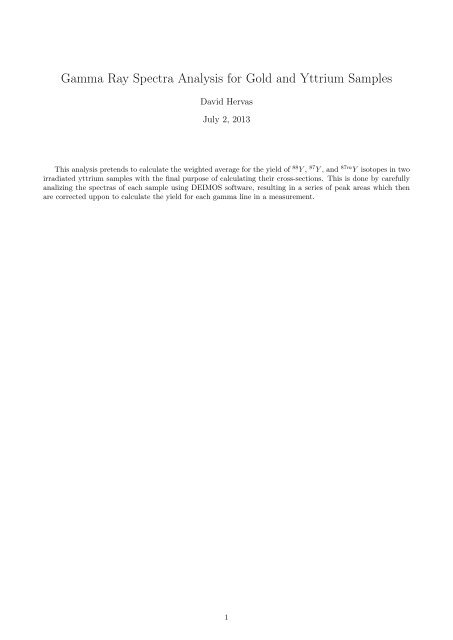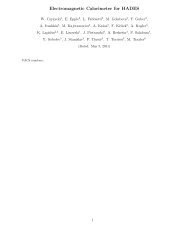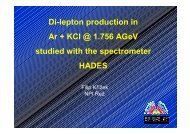Gamma Ray Spectra Analysis for Gold and Yttrium Samples
Gamma Ray Spectra Analysis for Gold and Yttrium Samples
Gamma Ray Spectra Analysis for Gold and Yttrium Samples
You also want an ePaper? Increase the reach of your titles
YUMPU automatically turns print PDFs into web optimized ePapers that Google loves.
<strong>Gamma</strong> <strong>Ray</strong> <strong>Spectra</strong> <strong>Analysis</strong> <strong>for</strong> <strong>Gold</strong> <strong>and</strong> <strong>Yttrium</strong> <strong>Samples</strong><br />
David Hervas<br />
July 2, 2013<br />
This analysis pretends to calculate the weighted average <strong>for</strong> the yield of 88 Y , 87 Y , <strong>and</strong> 87m Y isotopes in two<br />
irradiated yttrium samples with the final purpose of calculating their cross-sections. This is done by carefully<br />
analizing the spectras of each sample using DEIMOS software, resulting in a series of peak areas which then<br />
are corrected uppon to calculate the yield <strong>for</strong> each gamma line in a measurement.<br />
1
1 Brief theoretical background<br />
<strong>Gamma</strong> ray spectroscopy consists on the detection of gamma rays being emitted by decaying atomic nuclei.<br />
Different detectors are used <strong>for</strong> this purpose, but this analysis focuses on the use of a solid-state detector. The<br />
principal mechanisms in which gamma rays interact with a detector are the photoelectric effect, the compton<br />
effect <strong>and</strong> pair production. As an atomic nucleus decays gamma ray’s of specific energies are emmited <strong>and</strong><br />
proceed to interact with the detector. This interaction is then registered <strong>and</strong> analysed to determine the energy<br />
of the incoming gamma rays. The collection of this data (which <strong>for</strong>ms peaks at certain energies) is called<br />
a gamma spectrum, with the individual peaks being called gamma lines. In this analysis the gamma ray<br />
spectrum is analyzed by means of DEIMOS sofware to provide the energies of the registered gamma lines <strong>and</strong><br />
their respective peak areas. With this data the following equation is used to find the yield <strong>for</strong> the different<br />
isotopes in the sample.<br />
S p · C abs (E) · B a<br />
N Y ield =<br />
· treal 1 e λ·t0 λ · t irr<br />
· ·<br />
I γ · ε(E) · C g · C oi · C area t live m foil 1 − e −λ·t ·<br />
(1)<br />
real 1 − e −λ·tirr<br />
Where S p is the peak area, C abs (E) the energy dependant self absoption correction, B a the beam correction,<br />
I γ the gamma line intensity per decay, ε(E) the energy dependant detector efficiency, C g the correction <strong>for</strong><br />
efficiency change, C oi the correction <strong>for</strong> coincidences, C area the square-emitter correction, t real the measurement<br />
time on the detector, t live the live time of the detector, m foil the mass of the sample, λ the decay constant, t 0<br />
the time elapsed between end of irradiation <strong>and</strong> beginning of measurement <strong>and</strong> t irr the irradiation time. There<br />
are 5 main blocks to this <strong>for</strong>mula, the first,<br />
S p · C abs (E) · B a<br />
I γ · ε(E) · C g · C oi · C area<br />
Consists of the measured peak area corrected by all the theoretical corrections listed above, the most important<br />
being the detector efficiency <strong>and</strong> the intensity per decay. The peak detector efficiency describes what ratio<br />
of counts are counted by the detector of all the counts that are irradiated in 4π steradians while the gamma line<br />
intensity per decay describes the probability of a given decay to ocurr. Given the type of detector being used<br />
the efficiency depends on the energy of the desired gamma line, the following figure models this relationship.<br />
Figure 1: Efficiency of detector with respect to energy (keV) at 7 cm from detector (geom7)<br />
Furtheremore the efficiency of the detector depends on the distance of the sample from the detector itself.<br />
Given that the sample irradiates in 4π steradians the closer the sample is to the detector, the detector covers a<br />
1<br />
greater solid angle. The relationship is shown bellow, where the efficiency is of the order of<br />
d<br />
, where d is the<br />
2<br />
distance to the detector.<br />
2
Figure 2: Efficiency of detector with respect to geometry (distance from detector in cm) at 484 keV<br />
The second block,<br />
t real<br />
t live<br />
Is the dead time correction. After each count detected by the detector there is a small time span where<br />
the detector recuperates <strong>and</strong> cannot register any counts. This ratio corrects <strong>for</strong> the missed counts due to this<br />
1<br />
phenomenon. The third<br />
m foil<br />
is simply a mass normalization. While the <strong>for</strong>th <strong>and</strong> fifth<br />
e λ·t0<br />
1 − e −λ·t real<br />
,<br />
λ · t irr<br />
1 − e −λ·tirr<br />
account <strong>for</strong> the decay of the analyzed isotopes due to time elapsed during cooling <strong>and</strong> measurement, <strong>and</strong><br />
time elapsed durring irradiation respectively. When the yields <strong>for</strong> each measurement are calculated all the<br />
yields corresponding to one isotope must be the same regardless of the sample or measured gamma line. After<br />
grouping these yields the weighted average is calculated using the following <strong>for</strong>mula.<br />
¯X =<br />
n∑<br />
x i<br />
(∆x i) 2<br />
i=1<br />
(2)<br />
n∑<br />
1<br />
(∆x i) 2<br />
i=1<br />
Where ¯X is the weited average, n is the number of measurements <strong>for</strong> gamma lines pertaining only to one<br />
isotope, x i the calculated yields, <strong>and</strong> ∆x i the uncentainties of these yields expressed as area error in the results.<br />
Once this has been calculated one can procede to calculate the uncertainty of this weighted average by means<br />
of <strong>for</strong>mula 3.<br />
1<br />
∆X i =<br />
(3)<br />
n∑<br />
√ 1<br />
(∆x i) 2<br />
Finally<br />
χ2<br />
n−1<br />
is calculated using equation 4. Evedently the closer the result is to 1, the more coherent the<br />
results. There<strong>for</strong>e if this value deviates signicantly from 1, further procesing is required. This may include<br />
excluding outliers <strong>and</strong> applying other corrections.<br />
i=1<br />
χ 2<br />
n − 1 =<br />
n<br />
∑<br />
i=1<br />
(x i− ¯X) 2<br />
(∆x i) 2<br />
n − 1<br />
(4)<br />
3
In this experiment two samples of <strong>Yttrium</strong> are irradiated along with two samples of <strong>Gold</strong>, the principal<br />
purpose of which is to analyze the spectra of <strong>Yttrium</strong>. However, the gold samples are imcluded as a reference<br />
to check <strong>for</strong> consistency with know values of the <strong>Gold</strong> cross-section. The following in<strong>for</strong>mation concerns the<br />
irradiation period.<br />
Table 1: Irradiation data<br />
Start of Irradiation 3/22/13 22:12<br />
End of Irradiation 3/23/13 6:30<br />
Start Energy (MeV) 27.483<br />
End Energy (MeV) 27.158<br />
The masses of the <strong>Yttrium</strong> samples are as follows.<br />
m NY N1 = 1.8707g<br />
m NY O1 = 0.7580g<br />
Aditionally, the relevant gamma line in<strong>for</strong>mation <strong>for</strong> the three <strong>Yttrium</strong> isotopes is presented bellow.<br />
Table 2: <strong>Gamma</strong> lines <strong>for</strong> 88 Y : 106.65 day half life<br />
Energy (keV) Intensity per decay (%)<br />
1836.063 12 99.2 3<br />
898.042 3 93.7 3<br />
2734.086 13 0.71 7<br />
850.647 24 0.065 13<br />
1382.406 26 0.021 6<br />
3218.48 4 0.007 2<br />
Table 3: <strong>Gamma</strong> lines <strong>for</strong> 87 Y : 79.8 hour half life<br />
Energy (keV) Intensity per decay (%)<br />
388.531 3 82<br />
484.805 5 89.7 3<br />
Table 4: <strong>Gamma</strong> lines <strong>for</strong> 87m Y : 13.37 hour half life<br />
Energy (keV) Intensity per decay (%)<br />
380.79 7 78<br />
Finally the relevant gamma line in<strong>for</strong>mation <strong>for</strong> the four <strong>Gold</strong> isotopes is presented bellow.<br />
Table 5: <strong>Gamma</strong> lines <strong>for</strong> 196 Au: 6.183 day half life<br />
Energy (keV) Intensity per decay (%)<br />
355.684 2 87<br />
332.983 24 22.9 5<br />
426.0 1 7<br />
Table 6: <strong>Gamma</strong> lines <strong>for</strong> 198 Au: 2.695 day half life<br />
Energy (keV) Intensity per decay (%)<br />
411.80205 17 96<br />
675.8836 7 0.804 3<br />
4
Table 7: <strong>Gamma</strong> lines <strong>for</strong> 195 Au: 186.09 day half life<br />
Energy (keV) Intensity per decay (%)<br />
98.85 5 10.9 5<br />
Table 8: <strong>Gamma</strong> lines <strong>for</strong> 194 Au: 38.02 hour half life<br />
Energy (keV) Intensity per decay (%)<br />
328.455 11 61 3<br />
293.545 13 10.4 6<br />
2 Results<br />
Results are attached at the end.<br />
3 <strong>Analysis</strong><br />
3.1 88 Y Isotope<br />
Table 9: Weighted average of yield of 88 Y in NYN1 <strong>and</strong> NYO1 samples<br />
χ<br />
Sample Yield Weighted Average Uncertainty<br />
n−1<br />
NYN1 1137.8 · 10 7 1.4 · 10 7 16.5<br />
NYO1 1442.8 · 10 7 2.1 · 10 7 15.2<br />
Figure 3: Yield of 88 Y with respect to sample number (ordered by geometry) in NYN1 (blue) <strong>and</strong> NYO1 (red)<br />
samples. Weighted average <strong>for</strong> each sample is provided with the respective color at the value especified on Table<br />
9.<br />
It is evident from figure 3 that there are corresponding clusters in both samples that separate from the rest of<br />
the data. To analyze these clusters, the different gamma lines must be distinguishable while still maintaining<br />
the same order as in figure 3. Additionaly the weighted average <strong>for</strong> each gamma line within each sample has<br />
been calculated bellow.<br />
5
Table 10: Weighted average of yield of 88 Y in NYN1 <strong>and</strong> NYO1 samples <strong>for</strong> diferent gamma lines<br />
Sample Yield Weighted Average Uncertainty<br />
χ 2<br />
n−1<br />
1836.036 keV NYN1 1092.1 · 10 7 2.8 · 10 7 15.2<br />
898.042 keV NYN1 1154.2 · 10 7 1.6 · 10 7 4.19<br />
1836.036 keV NYO1 1398.6 · 10 7 4 · 10 7 20.8<br />
898.042 keV NYO1 1465.0 · 10 7 2.5 · 10 7 1.80<br />
Evidently the weighted average is significantly lower <strong>for</strong> the 1836.036 keV gamma line than <strong>for</strong> the 898.042<br />
keV gamma line. This is exemplified in the following figure.<br />
Figure 4: Yield of 88 Y with respect to sample number (ordered by geometry) in NYN1 (bottom left cluster)<br />
<strong>and</strong> NYO1 (upper right cluster) samples. The yields of the 1836.036 keV (red) <strong>and</strong> 898.042 keV (blue) gamma<br />
lines are represented along with their corresponding whighted average <strong>for</strong> each sample which value is specified<br />
in Table 10.<br />
This is due to the separated clusters discussed earlier. There<strong>for</strong>e, this is further analyzed by plotting the<br />
same data with enphasis on the 1836.036 keV gamma line, <strong>and</strong> its different measurent geometries (distances<br />
from the detector).<br />
6
Figure 5: Yield of 88 Y with respect to sample number (ordered by geometry) in NYN1 (bottom left cluster)<br />
<strong>and</strong> NYO1 (upper right cluster) samples. The yields of the 1836.036 keV gamma line are specified by geometry<br />
(in different colors) <strong>and</strong> all the yields <strong>for</strong> all geometries in 898.042 keV (light grey) gamma line are presented<br />
as reference.<br />
It is clear that the clusters consist of measurements pertaining from the same geometry only in the 1836.036<br />
keV gamma line. The most evident of these are geom17 <strong>and</strong> geom7 which significantly break off from the main<br />
set of data. This explains why<br />
χ2<br />
n−1<br />
is much smaller <strong>for</strong> the 898.042 keV gamma line than the 1836.036 keV<br />
gamma line. To resume, all this points to a miscallibration in the 1836.036 keV region.<br />
3.2 87 Y Isotope<br />
Figure 6: Yield of 87 Y with respect to sample number (ordered by geometry) in NYN1 (bottom left cluster)<br />
<strong>and</strong> NYO1 (upper right cluster) samples.<br />
7
Table 11: Weighted average of yield of 87 Y in NYN1 <strong>and</strong> NYO1 samples<br />
χ<br />
Sample Yield Weighted Average Uncertainty<br />
n−1<br />
NYN1 2122.3 · 10 6 1.4 · 10 6 69.2<br />
NYO1 2704.2 · 10 6 2.2 · 10 6 74.0<br />
Table 11 contains significantly high<br />
χ2<br />
n−1<br />
values which points to errors in the data, note that outliers have been<br />
removed. However, there is a tendancy in the yield data that cannot be appreciated in figure 6. By reorganizing<br />
the samples with respect to time elapsed from the end of irradiation to begining of measurement, that is from<br />
earliest measurement to latest, a clear trend can be observed in figure 7.<br />
Figure 7: Yield of 87 Y with respect to sample number (ordered by time elapsed from the end of irradiation<br />
to begining of measurement) in NYN1 (blue) <strong>and</strong> NYO1 (red) samples. Weighted average <strong>for</strong> each sample is<br />
provided with the respective color at the value especified on Table 11.<br />
The yield seems to increase <strong>and</strong> then stabalize. Figure 8 also depicts this, but yield is now ploted with<br />
respect to time, giving an acurate scale.<br />
8
Figure 8: Yield of 87 Y with respect to time elapsed from the end of irradiation to begining of measurement in<br />
NYN1 (blue) <strong>and</strong> NYO1 (red) samples.<br />
The conclusion is that a correction is clearly missing; just as if the correction <strong>for</strong> decay durring cooling <strong>and</strong><br />
measurement was eliminated one can observe the yield decaying with respect to time. This is explained by the<br />
presence of the isotope 87m Y , analyzed in the following section. This isotope decays quickly in comparison to<br />
the 87 Y isotope. When it decays, however, it decays into the 87 Y isotope itself, originaly increasing the yield <strong>for</strong><br />
said isotope. These values close to the end of irradiation must be eliminated (or corrected uppon), as in table<br />
13, to only analyze the yield when it stabalizes. Nevertheless, the weighted average of the yield was calculated<br />
separately <strong>for</strong> the different gamma lines to rule out any energy dependance as follows.<br />
Table 12: Weighted average of yield of 87 Y in NYN1 <strong>and</strong> NYO1 samples <strong>for</strong> diferent gamma lines<br />
Sample Yield Weighted Average Uncertainty<br />
χ 2<br />
n−1<br />
484.805 keV NYN1 2139.5 · 10 6 2.1 · 10 6 26.4<br />
388.531keV NYN1 2108.7 · 10 6 1.9 · 10 6 108<br />
484.805 keV NYO1 2734.1 · 10 6 3 · 10 6 48.0<br />
388.531keV NYO1 2680.5 · 10 6 3 · 10 6 97.5<br />
9
Figure 9: Yield of 87 Y with respect to sample number (ordered by time elapsed from the end of irradiation to<br />
begining of measurement) in NYN1 (bottom) <strong>and</strong> NYO1 (top) samples. The yields of the 1836.036 keV (red)<br />
<strong>and</strong> 898.042 keV (blue) gamma lines are represented along with their corresponding wheighted average <strong>for</strong> each<br />
sample which value is specified in Table 7.<br />
Since there is no significant deviation due to energy, the first 15 measurements are eliminated.<br />
Table 13: Weighted average of yield of 87 Y in NYN1 <strong>and</strong> NYO1 samples eliminating 15 first measurements<br />
(lowest t 0 ) <strong>for</strong> each sample<br />
χ<br />
Sample Yield Weighted Average Uncertainty<br />
n−1<br />
NYN1 2159.8 · 10 6 1.7 · 10 6 6.74<br />
NYO1 2806.5 · 10 6 3 · 10 6 4.99<br />
Concluding, the<br />
χ2<br />
n−1<br />
value is significantly lower when eliminating the uncorrected values, pointing towards<br />
a more coherent <strong>and</strong> consistent result.<br />
10
3.3 87m Y Isotope<br />
Figure 10: Yield of 87m Y with respect to sample number (ordered by geometry) in NYN1 (bottom left cluster)<br />
<strong>and</strong> NYO1 (upper right cluster) samples.<br />
Eliminating the two clear outliers in figure 10, the results are as follows.<br />
Table 14: Weighted average of yield of 87m Y in NYN1 <strong>and</strong> NYO1 samples<br />
χ<br />
Sample Yield Weighted Average Uncertainty<br />
n−1<br />
NYN1 1356.7 · 10 6 2.7 · 10 6 1.59<br />
NYO1 1761.8 · 10 6 4 · 10 6 0.870<br />
Figure 11: Yield of 87m Y with respect to sample number (ordered by geometry) in NYN1 (blue) <strong>and</strong> NYO1<br />
(red) samples. Weighted average <strong>for</strong> each sample is provided with the respective color at the value especified<br />
on Table 14.<br />
Again, the low<br />
χ2<br />
n−1<br />
value points towards a consistent result.<br />
11
3.4 Au Isotopes<br />
Table 15: Weighted average of yield of 196 Au in NAU1 <strong>and</strong> NAU2 samples<br />
χ<br />
Sample Yield Weighted Average Uncertainty<br />
n−1<br />
NAU1 818 · 10 7 1.1 · 10 7 19.2<br />
NAU2 191 · 10 7 4 · 10 7 32.8<br />
Figure 12: Yield of 196 Au with respect to sample number (ordered by geometry) in NAU1 (top left cluster) <strong>and</strong><br />
NAU2 (lower right cluster) samples.<br />
Table 16: Weighted average of yield of 198 Au in NAU1 <strong>and</strong> NAU2 samples<br />
χ<br />
Sample Yield Weighted Average Uncertainty<br />
n−1<br />
NAU1 2950 · 10 6 9 · 10 6 1.46<br />
NAU2 835 · 10 6 5 · 10 6 1.12<br />
12
Figure 13: Yield of 198 Au with respect to sample number (ordered by geometry) in NAU1 (top left cluster) <strong>and</strong><br />
NAU2 (lower right cluster) samples.<br />
Table 17: Weighted average of yield of 195 Au in NAU1 <strong>and</strong> NAU2 samples<br />
χ<br />
Sample Yield Weighted Average Uncertainty<br />
n−1<br />
NAU1 608 · 10 7 5 · 10 7 1.32<br />
NAU2 221 · 10 7 3 · 10 7 0.602<br />
Figure 14: Yield of 195 Au with respect to sample number (ordered by geometry) in NAU1 (top left cluster) <strong>and</strong><br />
NAU2 (lower right cluster) samples.<br />
Table 18: Weighted average of yield of 194 Au in NAU1 <strong>and</strong> NAU2 samples<br />
χ<br />
Sample Yield Weighted Average Uncertainty<br />
n−1<br />
NAU1 33.1 · 10 6 1.2 · 10 6 135<br />
NAU2 22.5 · 10 6 1.2 · 10 6 0.0111<br />
13
Figure 15: Yield of 194 Au with respect to sample number (ordered by geometry) in NAU1 (top left cluster) <strong>and</strong><br />
NAU2 (lower right cluster) samples.<br />
4 Conclusions<br />
Besides a miscalibration in the detector in the 1836 keV region <strong>and</strong> a yet uncorrected increase in 87 Y yield<br />
due to 87m Y decay, the results are consistent both theoreticaly <strong>and</strong> experimentaly. This is shown by low<br />
uncertainties <strong>and</strong> low<br />
χ2<br />
n−1<br />
values. The yields <strong>for</strong> all the different yttrium <strong>and</strong> gold isotopes were calculated<br />
succesfuly. Nevertheless, the yield <strong>for</strong> both samples should be the same <strong>for</strong> the same Isotope; evidently this is<br />
not so. This difference is partly due to the placement of the samples themselves due to an intrinsic difference<br />
in their geometries. Their thickness is diffent, thus the approximation of taking the sample as a point source<br />
fails to some extent. There<strong>for</strong>e further work must be done on this aspect to obtain one final coherent result <strong>for</strong><br />
each Isotope, additionaly the correction must be introduced <strong>for</strong> the 87 Y isotope.<br />
14
References<br />
[1] J. Frana, Deimos, NPI Rez, Czech Republic.<br />
[2] O. Svoboda, Experimental Study of Neutron Production <strong>and</strong> Transport <strong>for</strong> ADTT. (Czech Technical University<br />
in Prague, Prague, 2011).<br />
[3] P.Chudoba, Use of Activation Detectors <strong>for</strong> Neutron Field Measurement in Models of ADTS, (MFF UK<br />
Praha, 2013)<br />
[4] S.Y.F. Chu, L.P. Ekström, R.B. Firestone, Nuclear Data Search.<br />
(http://nucleardata.nuclear.lu.se/toi/index.asp, 1999).<br />
15





